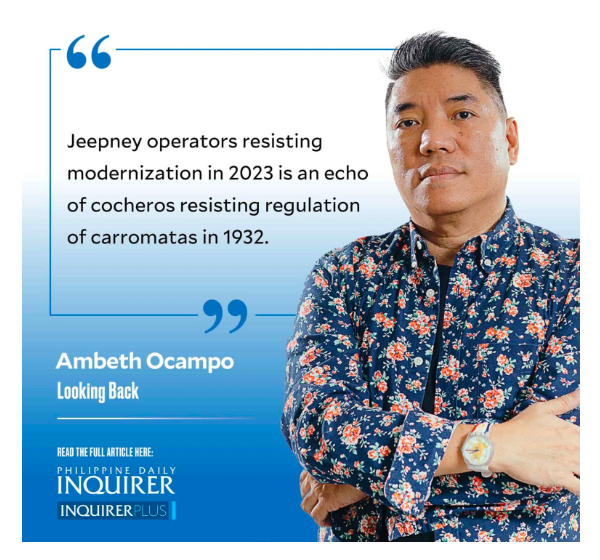King of the road in 1932: The ‘cochero’
Gadget Addict is one of my favorite online reality shows, even if it irritates me. Getting violators to hand over their license is harder than pulling teeth. Everyone has an excuse. Motorcycle riders caught wearing slippers or those without crash helmets, driver’s licenses, plate numbers, or registration papers scratch their heads saying “pasensya na, diyan lang ako.” Motorists being ticketed under a “no parking” sign scratch their heads, saying “pasensya na, sandali lang naman ako.” Motorists being ticketed for speeding or using the bus lane scratch their heads, saying “pasensya na, nagmamadali lang ako.” Others invoke the names of government officials or relatives in the uniformed services. When all else fails, the last resort is “puwede ba makiusap?” Traffic laws are negotiable. Everything is transactional.
Did we have written laws in pre-Spanish times? The once famous Code of Kalantiaw, promulgated in Aklan in 1433 has since been declared a 20th-century forgery and without historical basis. Are laws alien to our culture? Traffic violations need not be a drawn-out drama. Metropolitan Manila Development Authority does not confiscate violator’s licenses. A ticket is issued, a fine is paid at a bank or Bayad Center. Why resist a unified ticketing scheme in Metro Manila? Traffic violators are conditioned to transact, make palusot, name-drop, or simply offer a bribe, often higher than the fine, to avoid inconvenience. Municipalities confiscate violator’s licenses, then make it difficult to redeem. Traffic laws become negotiable when enforcers are given discretion.
My mother used to say the king of the road in the Philippines is the jeepney, or maybe she meant the jeepney driver. In 1932, a year before my mother was born, the king of the road was not the modern jeepney, that spawned from military jeeps discarded after World War II. King of the road was the cochero. Transport was horse-drawn, fueled by zacate or grass. These didn’t emit smoke but fumes from horse manure and urine.
In 1932, over a hundred carromatas traveled on P. Burgos street toward Manila City Hall. These carromatas were packed with cocheros instead of paying passengers. More cocheros came on foot, some carried placards that read “Hindi namin kailangan ang licencia!” or “Ayaw namin ng licencia!” This show of force was meant to influence the Manila council into withdrawing a proposed ordinance regulating carromatas in the city. Antonio C. Torres, president of the council, and other aldermen: Vicente Alindada, Vicente Bautista, Manuel de la Fuente, Jose Figueras, Miguel Halili, and Teofilo Mendoza were present. Vicente Albo, author of the cochero ordinance was absent. Mrs. Rosa Fojas, the “cochero queen” delivered an impassioned plea, both in Spanish and Tagalog, in behalf of the cocheros:
“During the last week, the police have persecuted or jailed more than 113 cocheros … The cocheros are poor and must earn a living someway … The Albo ordinance, if approved, would demolish one of the few businesses controlled wholly by Filipinos … Why don’t the police arrest owners of high-priced auto[mobiles] instead of the poor carromata drivers? … Will the board please consider my petition, respectfully submitted by the Carromata Owners Association and more than 5,000 cocheros?”
The session was suspended and Councilor Torres, as president of the council, went out of the session hall to address the protesters and promised them a fair shake. He was met with shouts in Tagalog, asking that their brother cocheros be released from jail and that the Albo ordinance be rejected. “King Cochero” an editorial in the Tribune from March 18, 1932, lamented that “There are so many cocheros that there are not enough policemen to arrest every carromata driver violating traffic rules … The cochero behaves as he does today because he has been permitted to do much as he wants. There has been too much condonation of his faults … It is a reflection of law enforcement in this city that the cocheros should be practically the dictators of traffic.”
Jeepney operators resisting modernization in 2023 is an echo of cocheros resisting regulation of carromatas in 1932. Going over the clippings compiled by Joseph Ralston Hayden in the Bentley Historical Library made me ask, when will the present stop reading like the past?
—————–
Comments are welcome at [email protected] There are so many cocheros that there are not enough policemen to arrest every carromata driver violating traffic rules … The cochero behaves as he does today because he has been permitted to do much as he wants
Disclaimer: The comments uploaded on this site do not necessarily represent or reflect the views of management and owner of Cebudailynews. We reserve the right to exclude comments that we deem to be inconsistent with our editorial standards.

